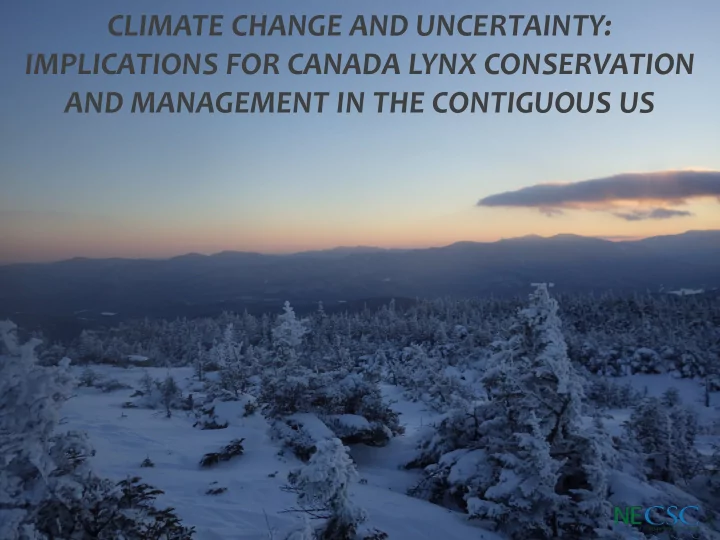

CLIMATE CHANGE AND UNCERTAINTY: IMPLICATIONS FOR CANADA LYNX CONSERVATION AND MANAGEMENT IN THE CONTIGUOUS US
CLIMATE MODELING 101 Accessed from: http://www.vets.ucar.edu/vg/T341/index.shtml
Lynx distribution and climate Historic distribution • Little Ice Age? (Hoving et al. • 2003) 1900 in northeast US (Hoving • et al. 2003) Lynx presence associated • w ith Snowpack persistence (≥4 • months; Gonzalez et al. 2007) Deep snowfall (≥270 cm/year; • Hoving et al. 2005)
How else may climate influence lynx? • Population cycles (Hone et al. 2011) and declines (Yan et al. 2013) • Population viability (Carroll 2007) • Increased competition w ith sympatric carnivores (Parker et al. 1983, Peers et al. 2013) • Reduced genetic diversity (Koen et al. 2014) • Access to hares (Watt 1973, Stenseth et al. 2004) • Coat color mismatch (Mills et al. 2013, 2014)
Increase in global mean surface temperature (GMST) -Natural variation can mask change, especially short-term -Attributed to the recent “climate hiatus” (15 yrs) -Overall trend is towards increased global temps especially after mid- 1970s -GMST may be increasing due to latest El Nino Seasonal GMST temperature trends compared to century mean (Trenberth 2015) event
Climate change and uncertainty in North America Winter • temperature projections Average of 40 • model runs and w armest and coolest scenarios Overall increase • in w inter temperature w ith greatest increase in northeast US Observed winter temperature and predictions based on common record (Deser et al. 2013) Uncertainty • given emission scenarios
Climate change and uncertainty in North America Winter • precipitation projections Average of 40 • model runs and w ettest and driest scenarios Increase in • precipitation in eastern US and Drier in the • Northw est US Uncertainty given • Observed winter precipitation and predictions based on common record (Deser et al. 2013) emission scenarios and spatial formation of clouds
Northw estern US: Predicted climate change Figures from Kunkel et al. (2013)
Northw estern US: Snow pack trends and projections Recent trends • Decrease in spring snow pack at low er elevations but • unequivocal at high elevation (Mote et al. 2008) Overall decline in snow pack the latter half of the 20 th • century (Mote et al. 2005; Pierce et al. 2008) Decrease in overall snow pack (Pierce and Cayan 2013; • Know les 2015) Low er proportion of w inter precipitation occurring as • snow (Know les et al. 2006) Projections • Low er proportion of w inter precipitation occurring as • snow and reduced number of snow fall days (Pierce and Cayan 2013; Lute et al. 2015) Decrease in snow fall season and snow fall (Pierce and • Cayan 2013).
Northern Rockies: Predicted Climate Change Figures from Kunkel et al. (2013)
Southern Rockies: Predicted climate change Figures from Kunkel et al. (2013)
Northern & Southern Rockies: Snow pack trends and projections Recent trends • Overall decline in snow pack the latter half of the 20 th • century (Pierce et al. 2008). Decrease in overall snow pack (Know les 2015). • Low er proportion of w inter precipitation occurring as • snow (Know les et al. 2006; Pierce and Cayan 2015). Projections • Low er proportion of w inter precipitation occurring as • snow and reduced number of number of snow fall days (Pierce and Cayan 2013; Lute et al. 2015) Decrease in snow fall season and snow fall (Pierce and • Cayan 2013).
Great Lakes: Predicted Climate Change Figures from Kunkel et al. (2013)
Great Lakes: Snow pack trends and projections Recent trends • Increase in lake effect snow (Andresen et al. 2012) and • longer snow seasons (Kunkel et al. 2007; Know les 2015) to the north. Projections • Increased w inter precipitation throughout Midw est, but • low er proportion occurring as snow (Notaro et al. 2014; Suriano and Leathers 2015). Increased lake effect snow around Lake Superior w ith • eventual decline tow ards end of century (Notaro et al. 2015). Increased lake effect snow north of eastern Great Lakes • then gradual decline (Suriano and Leathers 2015) Decline in snow fall and length of snow pack coverage • (Notaro et al. 2014; Notaro et al. 2015)
Northeast: Predicted Climate Change Figures from Kunkel et al. (2013)
Northeast: Snow pack trends and projections Recent trends • Reduction in number of snow covered days (Burakow ski et • al. 2008; Campbell et al. 2010; Bryan et al. 2015) and snow fall Low er proportion of w inter precipitation occurring as • snow (Huntington et al. 2003; Brian et al. 2015) Projections • Increased w inter precipitation (Raw lings et al. 2012; • Notaro et al. 2014), but low er proportion occurring as snow Decline in snow fall and length of snow pack coverage • (Notaro et al. 2014)
Acknow ledgements -Toni Lyn Morelli, PhD (USGS, NE CSC) -Mary Ratnaswamy, PhD (USGS, NE CSC) -Ambarish Karmalkar, PhD (NE CSC) -Alexander Bryan, PhD (NE CSC)
Recommend
More recommend